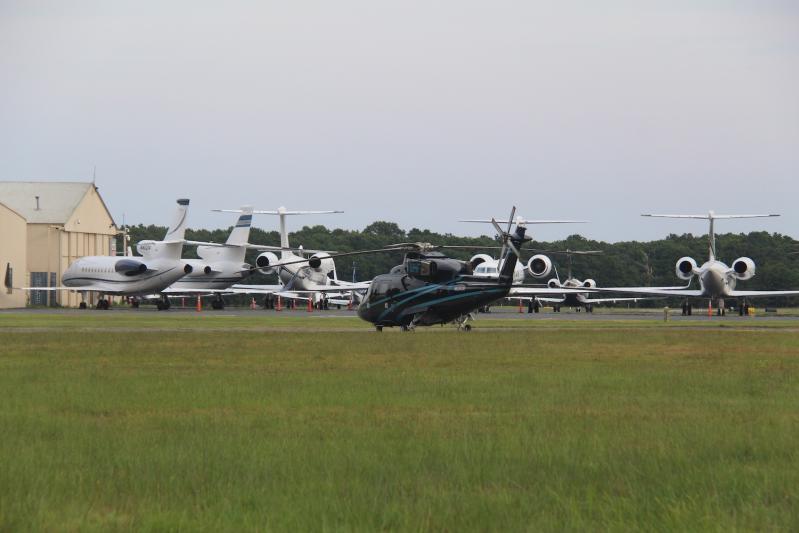If participants in last Thursday's workshop on a re-envisioning of East Hampton Airport agreed on anything, it was that the status quo is not acceptable. But there was sharp disagreement on virtually everything else with respect to how the airport's operations should change to lessen its impact on the town's residents, a large majority of whom do not use it.
Last Thursday's workshop was the first of four meant to advance a shared understanding of facts surrounding the airport, identify key issues of concern, and allow stakeholders to be heard before the town board makes any decisions.
Upon expiration of Federal Aviation Administration grant assurances this month, the town will regain control over the airport. It could allow its operation to continue as-is, enact restrictions or curfews on air traffic such as the elimination of commercial flights, close the airport and reopen it with new restrictions in place, or close the airport permanently and put the site to a new use.
Since May, the town board has been analyzing and discussing the airport and its future via fact-finding presentations, listening sessions, and other outreach efforts. Last week, the board heard estimates from its consultants as to how much air traffic might be diverted to other airports, including the privately owned Montauk Airport, should East Hampton Airport be closed. Previous work sessions have had presentations on environmental and economic impacts, land use and zoning, and airport planning and operations.
The workshops continued on Friday and Monday evening, with one more scheduled for this coming Monday at 7 p.m. All happen via Zoom video conference, and registration for the final session is at the town's website.
After an initial presentation by the consultants, Peter Flinker and Lisa Liquori, those attending the virtual workshops are randomly assigned to small groups for a one-hour session during which a moderator asks participants about their connection to the airport and how its operations affect them; whether or not the status quo is acceptable and why; what, if anything, should change, and how the needs of individuals, the community, and the airport's users and operators can best be balanced. The entire group then reconvenes, and the moderators summarize the opinions voiced in the small groups.
In last Thursday's workshop, a sizable majority in most groups favored closing the airport, according to their respective moderators. Concerns about noise and air pollution were paramount among them, though many felt that closing the airport entirely could have unintended consequences, Mr. Flinker said, so closure should be "thought through very carefully." Alternatively, he said, many participants suggested an end to all commercial flights and "reasonable, local use" so that the airport does not operate as "a taxi service" between New York City and the East End.
The group for which Ms. Liquori served as moderator was unanimous in saying they were negatively affected by the airport, she said, and in the belief that "there was no solution that would work other than complete closure of the airport." They cited "horrific impacts to quality of life" caused by aircraft noise, a threat to drinking water, and safety hazards, she said.
Traffic has grown out of control, another moderator summarized of his group's discussion, but that increased traffic supports restaurants and retail businesses in the town. Yet a majority of that group offered suggestions for the site following the airport's closure, including light industry and a solar farm. Others suggested that hangars at the airport be repurposed as art galleries and space for philanthropic events.
This reporter was assigned to a group that included advocates for the airport and opponents, of varying degree, to its continued existence. In the former camp were Alex Gertsen of the National Business Aviation Association and Kathryn Slye, a recreational pilot and vice president of the East Hampton Aviation Association. Also present were Patricia Currie of Noyac, a founder of Say No to KHTO, the airport's aviation designation; Carolyn Logan Gluck, who is the chairwoman of the Wainscott Citizens Advisory Committee but was not representing the committee, and Cate Rogers, a Democratic candidate for East Hampton Town Board.
Ms. Currie said that she has been disturbed by aircraft noise since the late 1990s, when she lived in Water Mill. "The noise has only gotten worse over two decades," she said. "I'm concerned that unless it closes completely, this nightmare will continue to go on."
Ms. Slye, who said she represented almost 100 local pilots, spoke of the "massive amount of financial benefits" of the airport and its "very rare ecosystem" that protects multiple threatened wildlife species. "We work hard to try to work with our community, to try to resolve any noise concerns," she said.
Mr. Gertsen said that the airport "plays a very important role on the East End of Long Island as a transport point," serving as a site for medical evacuations and as a potential location for airlifts of supplies in the event of catastrophic emergency. The airport is "an important economic engine for the community," he said, with many people reliant on it. The aviation community, he said, "has done a tremendous amount of work" to listen to residents, change flight paths and altitudes, and enact voluntary curfews.
Ms. Currie disagreed. The aviation industry is focused solely on profit, she said, and pilots "will always take the shortest, quickest path," which will "always be over my Town of Southampton and other neighboring towns to the west and north." Were the airport to close, "we would see fast track on fast rail," she said. Previous efforts to restrict air traffic were fruitless, she said. "The industry was not interested in any access restrictions" and "spoke very much against any curfews."
Ms. Logan Gluck said that helicopter pilots "in a hurry to get to New York City" cut corners on voluntary flight paths, passing over her house, and that she was saddened by those "unwilling to acknowledge what your neighbors are experiencing."
Ms. Slye said that, in fact, "we as a local pilot group do care," and the consensus among virtually every pilot is that "we want to find solutions." Ms. Logan Gluck was wrong, she said. "We don't want a status quo. It is probably unrealistic and unreasonable." She agreed that, with respect to helicopters, "there are way too many of them. . . . That is something that needs to be addressed."
But she added that "our community is not the same as it was 20, 30 years ago," citing increased population and attendant vehicular traffic and residential construction, "so why are we expecting the airport to have lived in some permanent, static bubble?" She also said that the airport's opponents "knew it was there when you bought your house," and that the airport operations haven't changed "with the exception of an increase in helicopters," which often fly low and are among the noisiest of aircraft.
Ms. Logan Gluck responded that she found it "deeply offensive" to say that she "chose to buy my house under where helicopters fly; I didn't." The burden, she said, "is on people who use the airport." If it is to continue, "it has to be done in a fashion that takes into consideration other people who live in the community. . . . I don't see the airport community acknowledge people whose lives are severely impacted by it."
But, she said, Ms. Slye's acknowledgement that helicopter traffic has become excessive and should be limited represents a small step forward. "Work to make that happen," she said, encouraging Ms. Slye to imagine how that could build goodwill between supporters and opponents of the airport.




